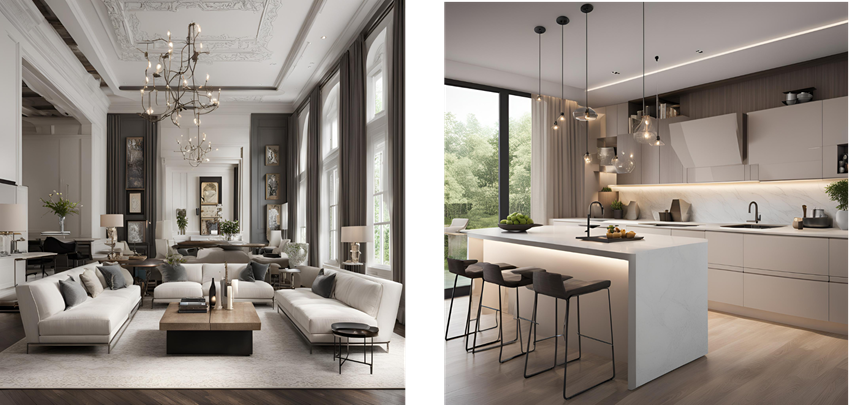Interior design styles have a significant impact on the overall look and feel of a space. Whether you’re decorating your home or working on a commercial project, understanding different design styles can help you make informed decisions. In this blog, we’ll explore ten timeless interior design styles that continue to inspire and captivate.
1. Minimalist: Less Is More
Minimalist design adheres to the “less is more” philosophy. Clean lines, neutral colors, and functional furniture create a serene atmosphere. Remove unnecessary clutter and focus on essential elements. Here’s how to embrace minimalism:
- Quality Over Quantity: Invest in high-quality, functional furniture.
- Declutter: Eliminate unnecessary decor and keep surfaces clear.
- Serene Atmosphere: Create a serene and calming environment.
2. Scandinavian: Minimalism and Natural Beauty
Scandinavian design celebrates minimalism, functionality, and natural materials. Originating in Nordic countries, it emphasizes simplicity and light Think of IKEA’s practical yet stylish pieces. Keep clutter to a minimum and embrace the concept of “hygge” (a Danish term for coziness). Here’s how to achieve the Scandinavian look:
- Neutral Color Palettes: Stick to neutral colors like whites, grays, and light blues.
- Natural Textures: Use materials like wood, wool, and linen.
- Uncluttered Spaces: Keep your spaces uncluttered and open.

3. Industrial: Raw and Rugged Charm
Industrial design draws inspiration from factories and warehouses. It’s all about raw, rugged charm. Exposed brick walls, metal accents, and open spaces define this style. Incorporate raw materials like steel, concrete, and distressed wood. Opt for utilitarian furniture and vintage lighting fixtures to create an industrial vibe. Key elements include:
- Exposed Brick: Incorporate exposed brick walls for an industrial vibe.
- Metal Pipes and Fixtures: Use metal pipes for shelving or lighting fixtures.
- Distressed Wood: Choose distressed wood furniture.
4. Traditional: Classic Elegance
Traditional design exudes classic elegance and comfort. Rich fabrics, ornate details, and symmetry define this style. Think of elegant furniture, chandeliers, and intricate moldings. To achieve a traditional look:
- Rich Fabrics: Think velvet, silk, and brocade.
- Antique Furniture: Invest in timeless pieces.
- Warm Color Palettes: Opt for warm colors like burgundy, deep green, and gold.

5. Mid-Century Modern: Subtle Sophistication
Mid-Century Modern design, which emerged in the mid-20th century, seamlessly blends subtle sophistication with functionality. Clean lines, organic shapes, and a focus on practicality define this style. Iconic pieces like the Eames Lounge Chair and the Saarinen Tulip Table epitomize Mid-Century Modern aesthetics. To achieve this style, focus on minimalism, natural materials, and bold geometric patterns. Choose:
- Choose Sleek Furniture: Opt for streamlined furniture with clean lines.
- Warm Wood Tones: Incorporate warm wood tones for a cozy feel.
- Bold Color Accents: Add pops of bold colors to create visual interest.
6. Art Deco: Glamour and Opulence
Art Deco design harks back to the Roaring Twenties. It’s all about glamour, opulence, and geometric patterns. To infuse Art Deco flair:
- Luxurious Materials: Velvet, marble, and lacquered finishes.
- Bold Colors: Think emerald green, gold, and black.
- Sunburst Motifs: Incorporate sunburst mirrors or patterns.

7. Bohemian: Eclectic Individuality
Bohemian design or “boho” design celebrates individuality and creativity. Mix and match patterns, textures, and colors. Layer rugs, use eclectic furniture, and incorporate plants. Embrace a free-spirited vibe with vintage finds and global influences:
Layered Textiles: Rugs, tapestries, and throw pillows.
- Global Treasures: Display unique finds from your travels.
- Cozy Nooks: Create inviting corners with floor cushions.
8. Rustic: Warm and Inviting
Rustic design brings the outdoors in. Wood, stone, and natural textures dominate this style. Think of log cabins, exposed beams, and cozy fireplaces. Use earthy tones, distressed finishes, and handmade items to create a warm and inviting space:
Natural Materials: Use reclaimed wood and stone.
- Distressed Furniture: Embrace imperfections.
- Vintage Accessories: Think lanterns, old crates, and woven baskets.

9. Transitional: Balancing Old and New
Transitional design merges classic and contemporary elements. It balances classic elegance with modern simplicity. Mix antique and modern furniture, incorporate neutral colors, and maintain a harmonious flow throughout the room:
Neutral Palettes: Stick to neutral colors.
- Comfortable Furniture: Choose pieces that bridge the gap between old and new.
- Subtle Patterns: Incorporate subtle patterns in textiles and accessories.
10. Contemporary: Embracing the Now
Contemporary design is ever-evolving and reflects the current trends. It combines elements from various styles, emphasizing clean lines, open spaces, and a neutral color palette. Focus on comfort and functionality while staying up-to-date with design innovations:
- Mix of Materials: Combine metal, glass, and wood.
- Bold Artwork: Showcase striking artwork.
- Streamlined Furniture: Opt for sleek,

Conclusion
Understanding these ten interior design styles allows you to make informed choices when decorating your space. Whether you prefer the sleek lines of mid-century modern or the cozy charm of bohemian, there’s a style that resonates with you. Remember to consider functionality, aesthetics, and personal preferences as you create a space that reflects your unique taste.